Do you dream of transforming your living space into a minimalist haven?
Embracing minimalist house design is more than adopting an architectural style; it’s about creating a serene and functional sanctuary in our often chaotic world.
This article delves into the heart of minimalist house design for 2024, showcasing how simplicity and practicality can merge to form elegant, tranquil homes.As we explore the core principles of minimalist architecture, you’ll discover how embracing less can enrich your life with more: more space, more peace, and more harmony. From clean architectural lines to the strategic use of space and natural light, this guide offers valuable insights for crafting a minimalist home that resonates with both style and tranquility.
Join us on this journey to understand how minimalist house design can be a pathway to a purposeful and serene existence, turning your dream of a minimalist home into a beautiful reality.
Understanding Minimalist House Design
Minimalist house design is a style of architecture that focuses on simplicity, functionality, and the use of minimal elements. It involves designing a home with a minimal number of objects, furniture, and decorations to create a clean and uncluttered living space.
The minimalist house design philosophy is based on the idea that less is more. The goal is to create a living space that is simple, functional, and aesthetically pleasing. Minimalist houses are designed to be clean and uncluttered, with a focus on open spaces and natural light.
Minimalist homes are often characterized by their simple, geometric shapes and neutral color palettes. The use of natural materials such as wood, stone, and concrete is also common in minimalist house design.
A minimalist house design is not only aesthetically pleasing, but it also promotes a sense of calm and relaxation. By eliminating clutter and unnecessary objects, a minimalist home can help to reduce stress and anxiety.
Key Principles of Minimalist Design
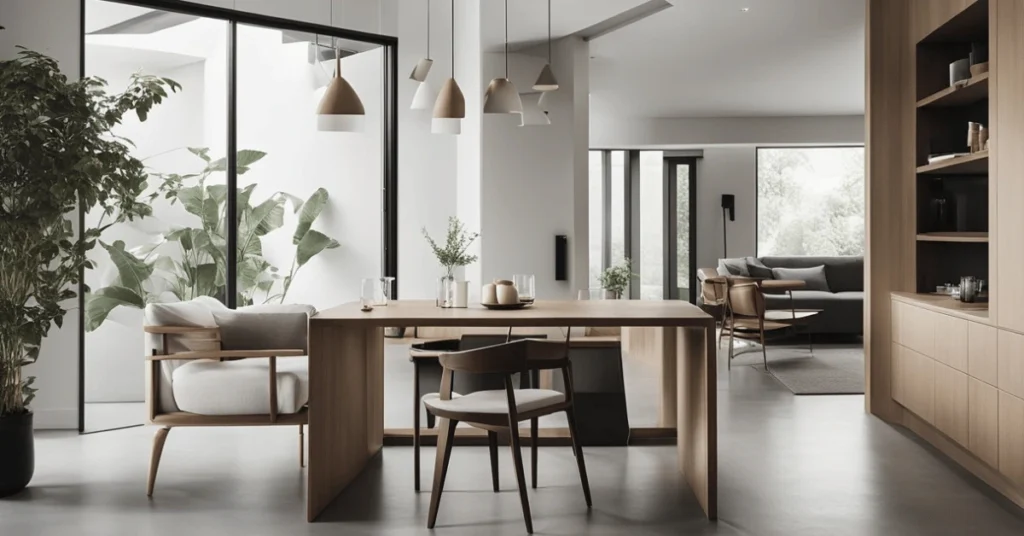
Space
One of the most important principles of minimalist design is space. We believe that every element in a room should have a purpose and that there should be plenty of open space. This helps create a sense of calm and tranquility in the room. We often use neutral colors and clean lines to help emphasize the space in a room.
Simple
Minimalist design is all about simplicity. We believe that less is more when it comes to your minimal house design. We try to eliminate any unnecessary clutter or decorations and focus on the essentials. This helps create a space that is both elegant and functional.
Functional
Another important principle of minimalist design is functionality. We believe that every element in a room should serve a purpose. We try to design spaces that are both beautiful and practical. This means choosing furniture and decor that not only looks good but also serves a purpose.
Minimalist Decor
Minimalist decor is a key component of minimalist house design. We often choose decor that is simple and elegant. We prefer natural materials like wood, stone, and metal. We also use plants to help bring life and color to a room.
Clean Lines
Clean lines are another important aspect of minimalist design. We believe that furniture and decor should have simple, clean lines. This helps create a sense of order and balance in a room.
Simplicity
Simplicity is at the heart of minimalist design. We believe that a space should be easy to understand and navigate. We try to eliminate any unnecessary complexity and focus on the essentials.
Less is More
Finally, we believe that less is more when it comes to designing a space. We try to eliminate any unnecessary clutter or decorations and focus on the essentials. This helps create a space that is both elegant and functional.
Influence of Minimalist Architects and Designers
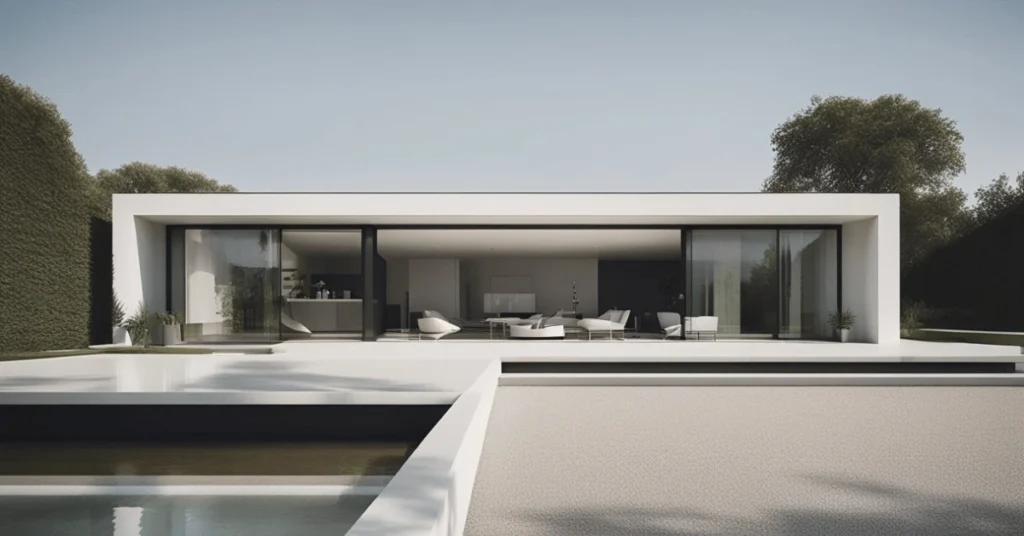
There are several architects and designers who have made significant contributions to the movement of minimalism. We can see their influence in many of the minimalist homes that exist today.
One of the most well-known minimalist architects is Donald Judd. He was not only an architect but also a sculptor and furniture designer. His work regarding minimalist house design was characterized by clean lines, simple geometries, and a focus on materials. Judd’s minimalist philosophy was based on the idea that art and architecture should be stripped down to their essential elements.
Another influential figure in minimalist architecture is the midcentury-modern architect Richard Neutra. He believed that architecture should be in harmony with its surroundings and that a building should be designed to enhance the natural environment. Neutra’s work was characterized by clean lines, open spaces, and a focus on natural light.
In addition to these architects, there are also many minimalist designers who have made significant contributions to the movement. Some of the most well-known minimalist designers include Dieter Rams, Jasper Morrison, and Naoto Fukasawa. These designers are known for their focus on simplicity, functionality, and the use of natural materials.
The Minimalist Color Palette
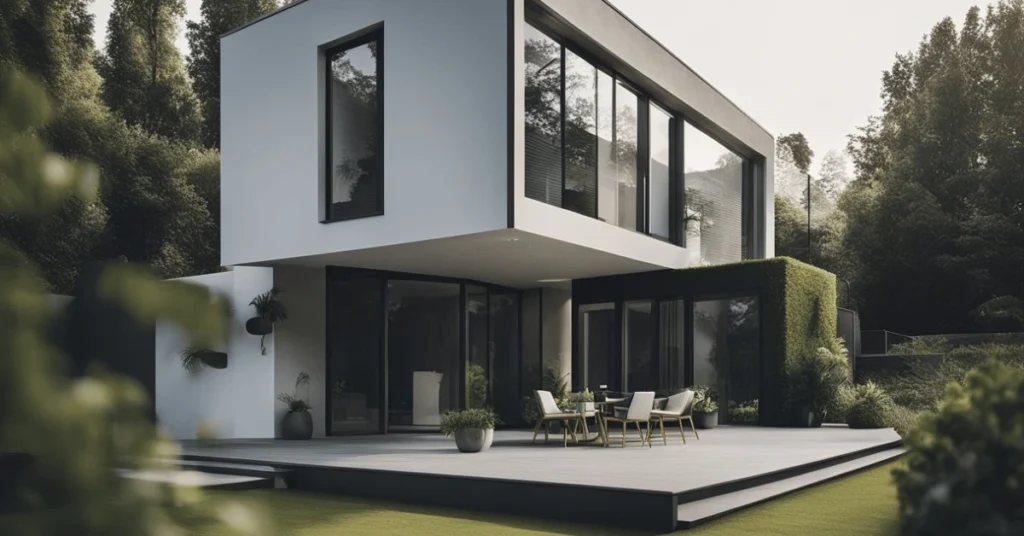
The color palette is a crucial aspect for the minimalist house design that sets the tone for the entire space. As we aim for a clean and uncluttered look, we prioritize a neutral color scheme that is both calming and timeless.
Black and white are the primary colors in a minimalist color palette. White space is essential in creating a sense of openness, while black adds contrast and depth. Together, they create a classic and sophisticated look.
While black and white may seem limiting, a minimalist color palette can also include other colors. Monochromatic color palettes, which use different shades of the same color, can add interest without overwhelming the space. For example, shades of gray can create a serene and calming atmosphere.
Incorporating Natural Elements in Minimalist Design
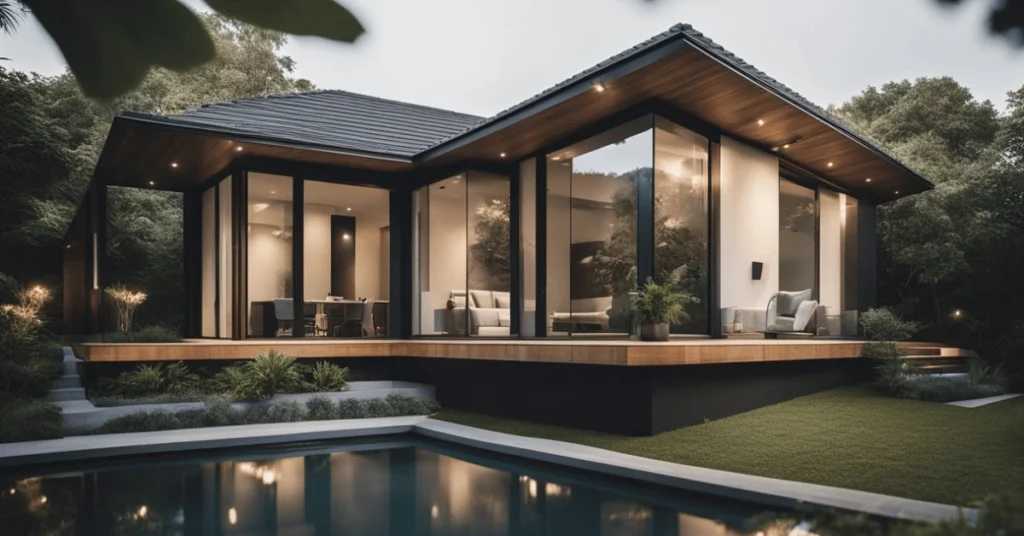
Also, incorporating natural elements can add warmth and depth to the space. Natural elements such as natural light, natural materials, nature, and indoor plants can help create a calming and inviting atmosphere.
Natural light is an essential element in minimalist house design. It can make a space feel larger and brighter while reducing the need for artificial lighting. Large windows, skylights, and open floor plans can help maximize natural light in a home. Additionally, choosing light-colored walls and furniture can help reflect natural light and create a bright and airy feel.
Natural materials, such as wood, stone, and brick, can add texture and warmth to a minimalist home. These materials can be used in flooring, accent walls, and furniture. When choosing natural materials, it’s important to consider their durability and sustainability.
Nature can also be incorporated into minimalist design through artwork and decor. Landscape photography, botanical prints, and natural textures such as woven baskets or driftwood can bring the outdoors inside and add visual interest to a minimalist space.
Indoor plants are another way to incorporate nature into a minimalist home. Plants not only add a pop of color but can also improve air quality and reduce stress levels. When selecting plants, it’s important to choose varieties that thrive in the home’s specific lighting and temperature conditions.
Choosing Minimalist Furniture
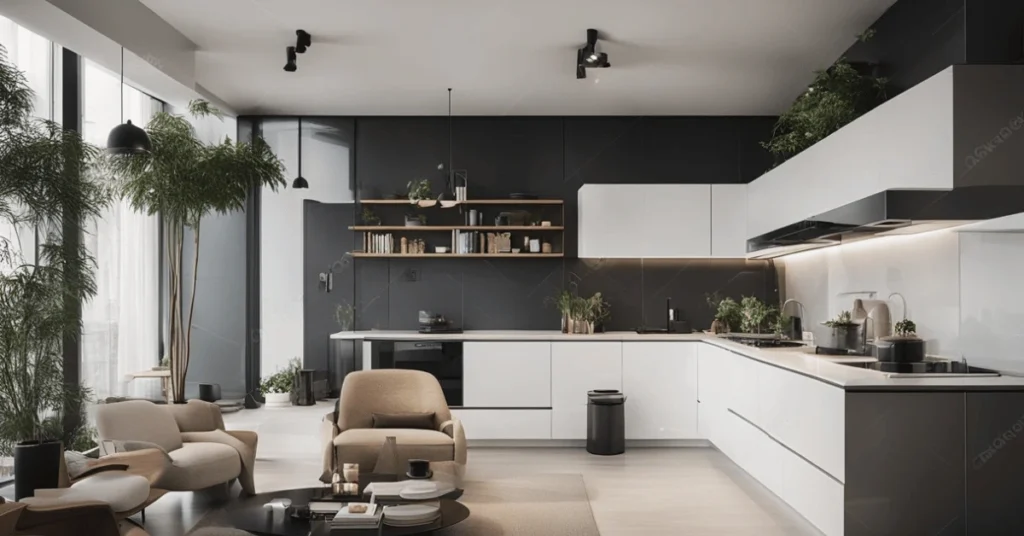
We want to ensure that the furniture we select is not only aesthetically pleasing but also functional and durable.
One of the key principles of minimalist design is to focus on quality over quantity. We should aim to invest in high-quality furniture that will last for many years rather than opting for cheaper, disposable pieces.
Functional furniture is also a must-have in a minimalist house design. Pieces that serve multiple purposes, such as a sofa bed or a storage ottoman, are ideal. This not only saves space but also reduces clutter.
When selecting furniture pieces, we should focus on simplicity and clean lines. Minimalist furniture is often characterized by its sleek, modern design. Avoid pieces with excessive ornamentation or unnecessary details.
In addition to the design, we should also consider the materials used in the furniture. Natural materials such as wood, leather, and linen are popular choices in minimalist design. These materials not only add warmth and texture to a space but also age beautifully.
Minimalist Design in Different Rooms
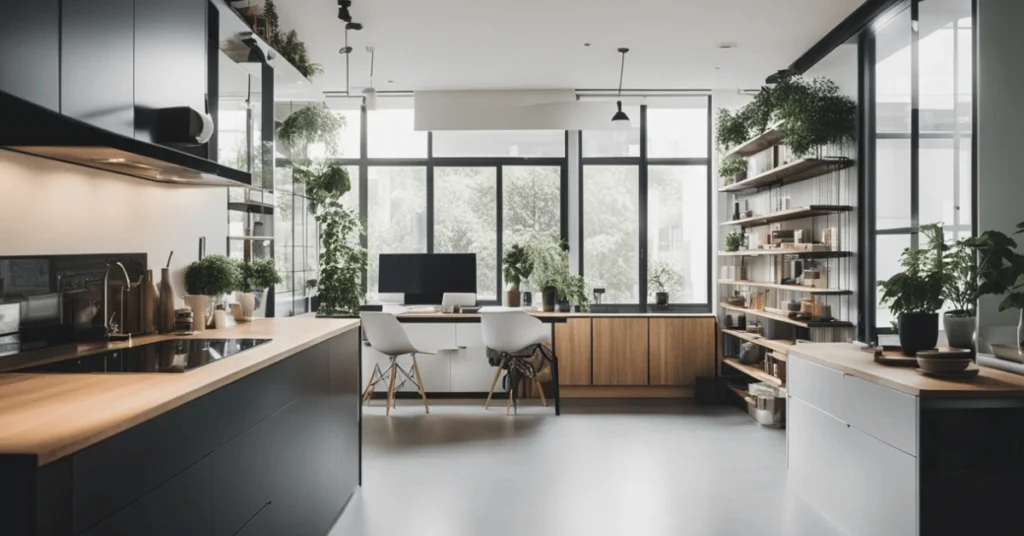
Here are some tips for achieving a minimalist look in different rooms:
Living Room
In the living room, the goal is to create a space that is both functional and comfortable. To achieve a minimalist look, keep furniture to a minimum and choose pieces that are simple and streamlined. A neutral color palette can also help create a calming atmosphere. Consider incorporating a statement piece, such as a piece of art or a unique light fixture, to add visual interest without cluttering the space.
Dining Room
In the dining room, the focus should be on creating a welcoming space for entertaining. Keep the table and chairs simple and unadorned, and choose a few key decorative elements, such as a vase of fresh flowers or a simple centerpiece. A neutral color palette can also help create a serene atmosphere.
Bedroom
In the bedroom, the goal is to create a peaceful and restful space. Choose a simple bed frame and bedding, and keep decorative elements to a minimum. A neutral color palette can help create a calming atmosphere, but don’t be afraid to add a pop of color with a throw pillow or a piece of art.
High Ceiling
High ceilings can be a challenge when it comes to minimalist house design, as they can make a space feel empty and cavernous. To combat this, consider adding tall plants or a statement light fixture to draw the eye upward. Keep furniture and decorative elements low to the ground to balance out the vertical space.
Storage Solutions for a Minimalist Home
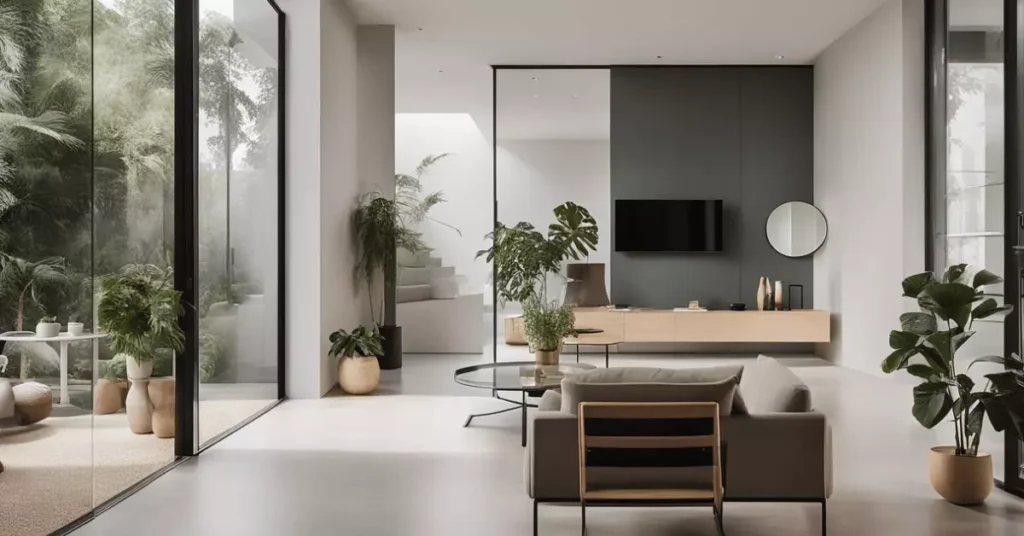
Shelves
Shelves are a great way to add storage to a minimalist house design without taking up too much space. Floating shelves are especially popular in minimalist design, as they create the illusion of more space and keep the room feeling open and airy. They can be used to display books, plants, or other decorative items, while also providing storage for everyday items.
Built-in Storage
Built-in storage is another great option for a minimalist home, as it allows you to maximize space while keeping everything hidden away. Built-in cabinets and drawers can be customized to fit your specific storage needs, and can be designed to blend seamlessly with the rest of the room.
Multipurpose Furniture
When space is limited, multipurpose furniture can be a lifesaver. For example, a storage ottoman can provide extra seating while also serving as a place to store blankets and pillows. A bed with built-in drawers can provide ample storage for clothing and linens, while also saving space in the room.
Declutter Regularly
No matter how many storage solutions you have, clutter can still accumulate over time. To keep your minimalist home clutter-free, it’s important to regularly declutter and get rid of items that are no longer necessary. This will not only help keep your home looking tidy, but it will also help you maintain a minimalist mindset.
Lighting in a Minimalist Home
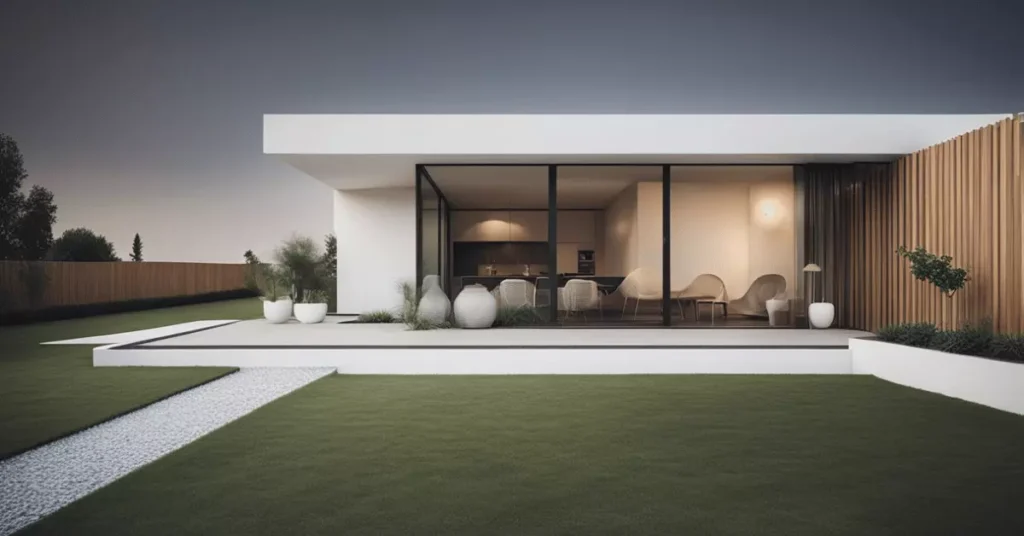
From us to you – here are some tips on how to achieve the perfect lighting in your minimalist house design.
Natural Light
One of the most important aspects of lighting in a minimalist home is natural light. We want to make the most of the available natural light and use it to create a bright and airy space. This means keeping windows unobstructed and using light-colored window treatments that allow light to filter through.
Artificial Light
When it comes to artificial lighting, we want to keep it simple and functional. We recommend using light fixtures that are sleek and understated, such as pendant lights or track lighting. These types of fixtures provide ample lighting without taking up too much visual space.
Lighting Zones
In a minimalist home, it’s important to create different lighting zones for different activities. For example, we might want to have bright lighting in the kitchen for cooking, but softer lighting in the living room for relaxation. This can be achieved by using dimmer switches or different types of light fixtures in different areas of the home.
Bulb Types
Finally, it’s important to consider the type of bulbs we use in our minimalist home. We recommend using LED bulbs, which are energy-efficient and long-lasting. They also provide a bright, white light that is perfect for aesthetics within a minimalist house design.
By following these tips, we can create the perfect lighting in our minimalist home. With a focus on natural light, simple fixtures, and different lighting zones, we can achieve a bright and inviting space that is both functional and beautiful.
The Role of Texture in Minimalist House Design
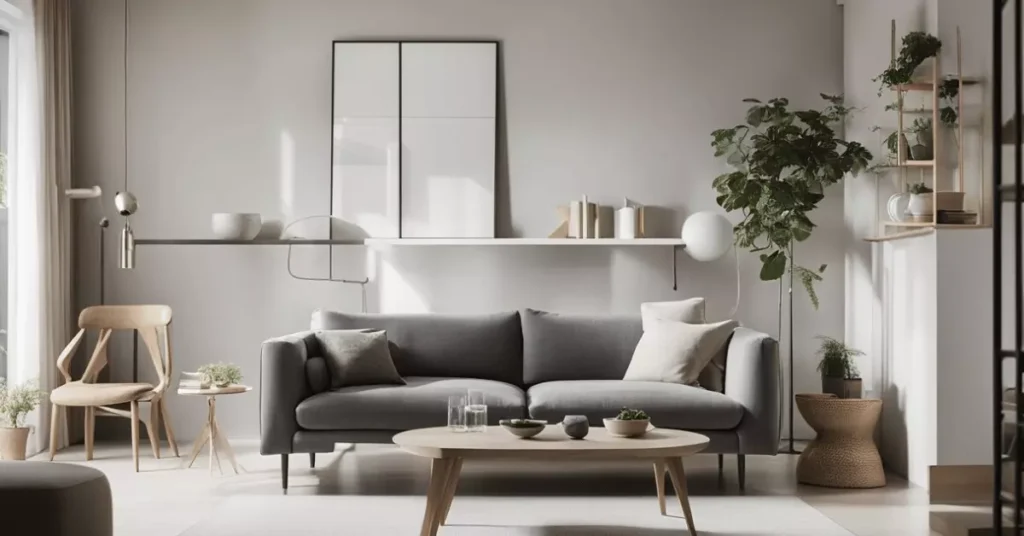
By using texture strategically, we can add visual interest and tactile sensations that enhance the overall aesthetic of a space.
Textures can be introduced in a variety of ways, such as through textiles, natural materials like wood or stone, or even through different finishes on flat surfaces. It’s important to balance the use of textures to avoid overwhelming the space and detracting from the minimalist aesthetic.
Geometric shapes are a common element in minimalist design, and they can also be used to introduce texture. By incorporating shapes like triangles or hexagons into the design, we can create a sense of depth and add visual interest without adding unnecessary clutter.
Flat surfaces are also a key component of minimalist house design, and they can be used to create a sense of calm and simplicity. However, flat surfaces can also be enhanced with texture, such as through the use of matte or glossy finishes.
The Impact of Minimalism on Lifestyle
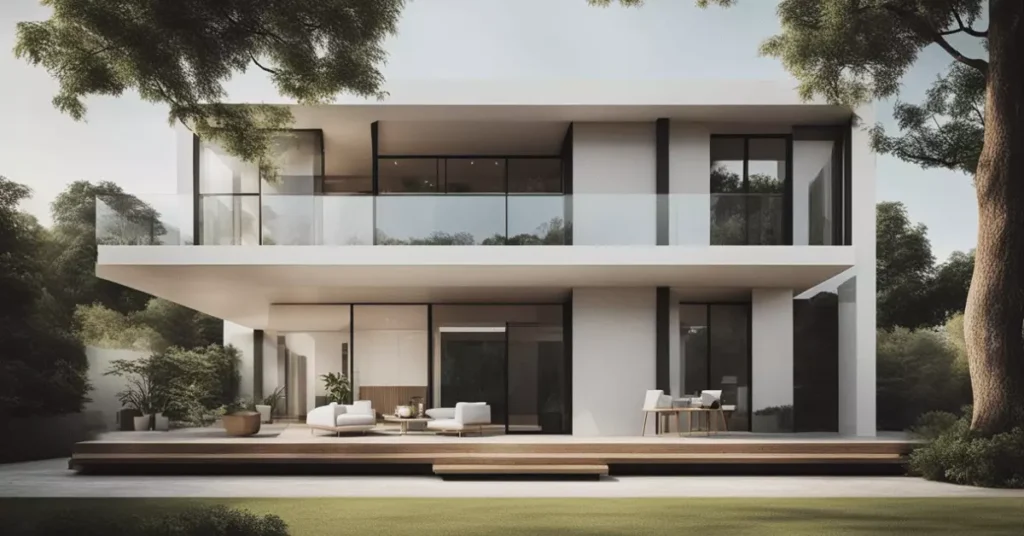
Minimalism is not just a design style, but also a way of life. It is a philosophy that advocates for simplicity, clarity, and intentionality. Embracing minimalism can have a profound impact on our lifestyle, from decluttering our homes to reducing stress and promoting relaxation.
One of the main benefits of minimalism is decluttering. By getting rid of unnecessary possessions, we can create more physical and mental space in our lives. This not only makes our homes look cleaner and more organized, but also helps us focus on what really matters. We can prioritize our time and energy on the things that bring us joy and fulfillment, rather than being bogged down by material possessions.
Minimalist House Design also promotes peace and calm. By simplifying our environment, we can reduce visual and mental clutter, which can be overwhelming and stressful. A minimalist house design is thought to be a sanctuary, a place where we can relax and recharge. It is a space that fosters a sense of calm and tranquility, which can have a positive impact on our mental health.
In addition to promoting peace and calm, minimalism can also create a cozy and inviting atmosphere. By focusing on quality over quantity, we can invest in high-quality items that are both functional and aesthetically pleasing. This can create a warm and welcoming environment that invites us to slow down and enjoy the simple pleasures of life.
Minimalist House Design Styles
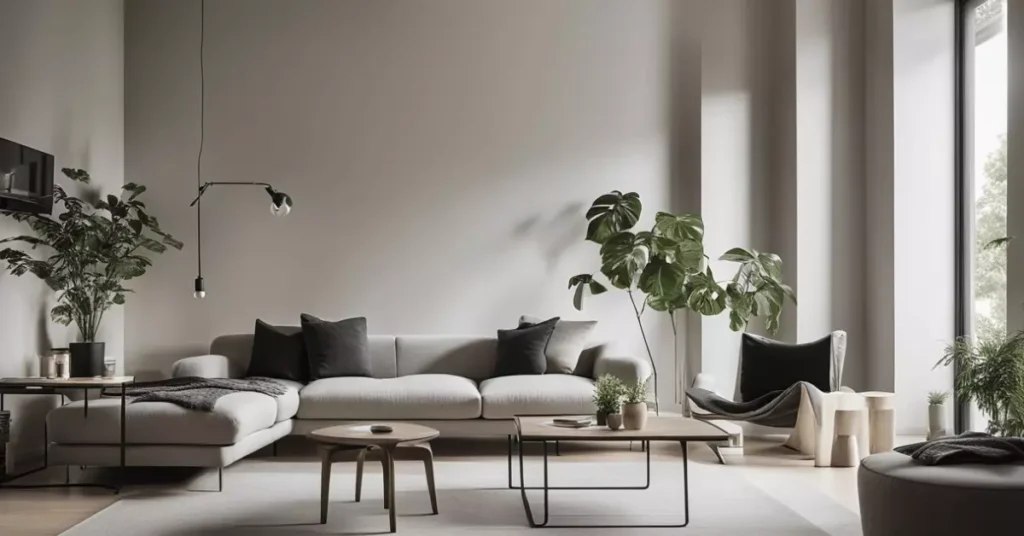
Scandinavian
Scandinavian design is all about simplicity, functionality, and minimalism. This style originated in the Nordic countries and has gained popularity worldwide. It is characterized by its use of light, neutral colors, natural materials such as wood and stone, and clean lines.
Farmhouse
Farmhouse design style is a mix of rustic and modern elements. It is characterized by its use of natural materials such as wood and stone, neutral colors, and simple lines. This style is all about creating a warm and inviting atmosphere.
Modern Home
Modern home design is all about clean lines, simplicity, and functionality. It is characterized by its use of geometric shapes, neutral colors, and minimal decoration. This style is perfect for those who want a sleek and sophisticated look.
Beach House
Beach house design style is all about creating a relaxed and laid-back atmosphere. It is characterized by its use of light colors, natural materials such as wood and wicker, and nautical elements. This style is perfect for those who want to bring the beach vibe into their home.
California
California design style is a mix of modern and bohemian elements. It is characterized by its use of natural materials such as wood and leather, neutral colors, and vintage pieces. This style is all about creating a relaxed and casual atmosphere.
Warm Minimalism
Warm minimalism is a new trend in minimalist house design. It is characterized by its use of warm colors, soft textures, and natural materials such as wood and wool. This style is perfect for those who want a minimalist look but also want to create a cozy and inviting atmosphere.
Personalizing Your Minimalist Home
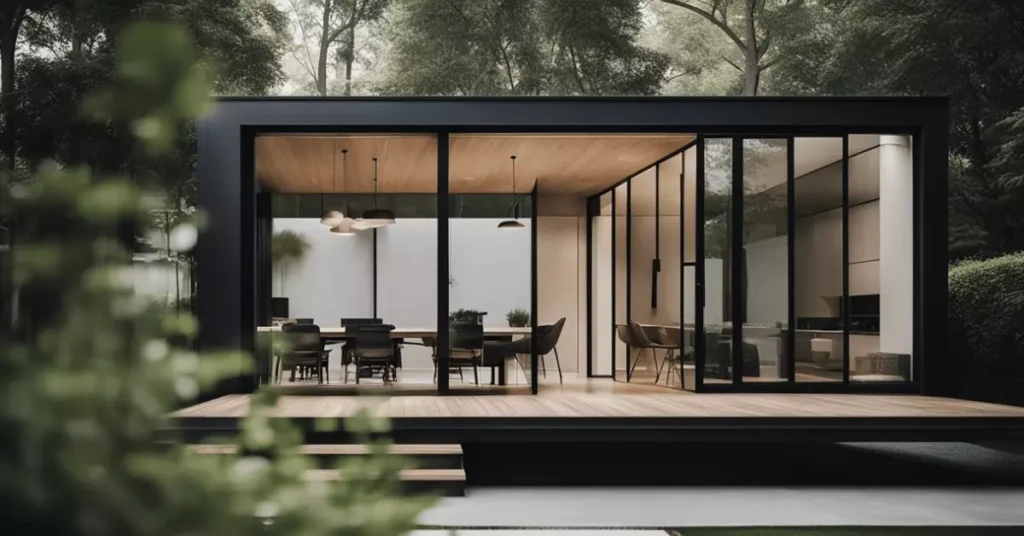
We believe that your home should reflect your personal style and vision. This is why we recommend taking the time to carefully consider your preferences and what you want your home to look and feel like.
One of the benefits of minimalist design is that it is elegant and timeless. By keeping things simple and sophisticated, your home will never go out of style. This is why we suggest opting for a neutral backdrop, such as white or beige walls, to create a clean and cohesive look.
However, just because you are keeping things simple doesn’t mean your home has to be boring. Adding pops of color or texture through accent pieces, such as throw pillows or rugs, can add visual interest and personality to your space. This is where you can really let your personal style shine.
When personalizing your minimalist house design, it’s important to keep in mind the overall aesthetic you are trying to achieve. If you want a more modern look, stick to clean lines and minimal decor. If you prefer a cozier vibe, incorporate soft textures and warm lighting.
Minimalist Design on Social Media
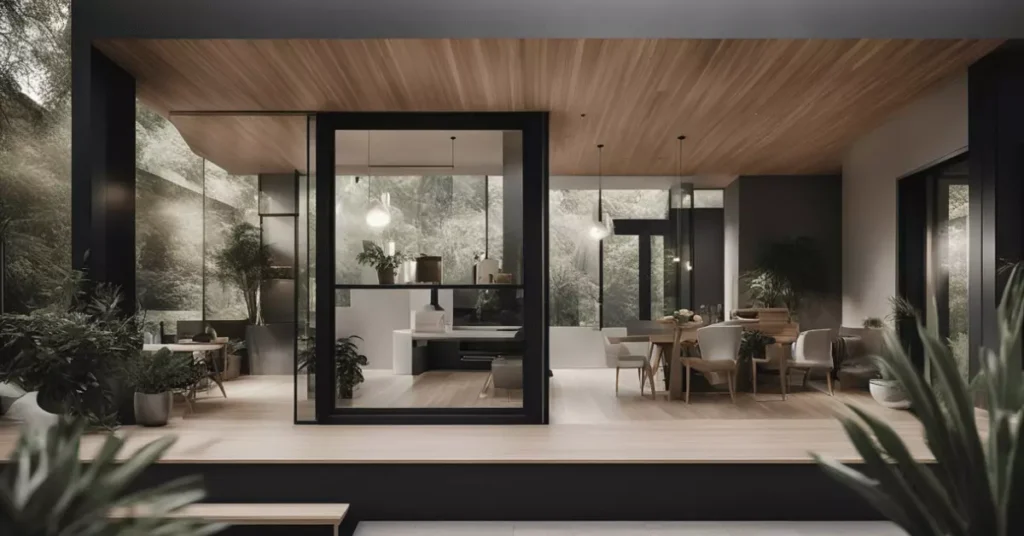
As minimalist design continues to gain popularity, social media platforms like Pinterest and Instagram have become hotspots for inspiration and ideas. We have noticed a growing trend of users sharing their minimalist homes and decor on these platforms, showcasing how they have implemented the design philosophy in their own lives.
Pinterest is a particularly valuable resource for minimalist design inspiration, with thousands of boards dedicated to the topic. Users can easily search for specific keywords and find a plethora of images and articles on the subject. We have found that Pinterest is especially useful for finding DIY projects and tutorials on how to create minimalist decor pieces.
Instagram is also a great platform for minimalist house design, with many users sharing photos of their own homes and decor. We have noticed that many of these users also tag the brands they have purchased their minimalist items from, making it easy for others to find similar products. Additionally, many brands themselves have Instagram accounts where they showcase their minimalist products and provide design inspiration.
The Role of Empty Space in Minimalist House Design

In minimalist design, empty space plays a crucial role in creating a sense of calmness and simplicity. By removing unnecessary clutter and decorations, we allow the space to breathe and become the focal point of the design. This approach is often referred to as “less is more.”
Empty space can be used in a variety of ways to enhance the minimalist house design. For example, by leaving large areas of blank wall, we can create a sense of openness and lightness in the room. This can be especially effective in smaller spaces where clutter can quickly make a room feel cramped.
Another way to use empty space is to create contrast with the objects in the room. By placing a few carefully chosen pieces of furniture or decor against a plain background, we can draw attention to them and create a sense of balance and harmony.
In minimalist design, the use of empty space is not just about removing things, but also about creating a sense of order and purpose. By carefully considering the placement of each item in the room, we can create a sense of flow and movement that enhances the overall design.
The Appeal of Minimalist Homes
Minimalist homes have become increasingly popular in recent years, and it’s not hard to see why. There are a number of reasons why people are drawn to the simplicity and elegance of minimalist design.
First and foremost, minimalist homes are incredibly stylish. They feature clean lines, neutral colors, and a focus on functionality over decoration. This creates a sense of calm and order that is both aesthetically pleasing and relaxing.
Another appeal of minimalist homes is their versatility. They can be adapted to a wide range of environments and settings, from urban apartments to rural retreats. Whether you’re living in a bustling city or a remote corner of the world, a minimalist home can provide a sense of peace and tranquility.
Minimalist homes are also environmentally friendly. By reducing the amount of materials and energy required to build and maintain a home, minimalist design can help to reduce our carbon footprint and preserve natural resources.
Finally, minimalist house design can be a great way to simplify your life. By eliminating clutter and unnecessary possessions, you can focus on the things that truly matter to you. This can lead to a greater sense of fulfillment and happiness in your daily life.
What is minimalist house design?
Minimalist house design emphasizes simplicity, functionality, and clean lines, focusing on essential elements for uncluttered and tranquil living spaces.
How do minimalist homes utilize space?
They maximize open space, minimize clutter, and use multi-functional furniture, creating a sense of openness and calm.
What materials are common in minimalist house design?
Natural materials like wood, stone, and concrete are popular, offering a blend of simplicity and elegance.
Can minimalist design be cozy?
Yes, through the strategic use of warm textures, soft lighting, and neutral colors, minimalist homes can be both stylish and cozy.
What are the benefits of minimalist living?
It offers a decluttered, stress-free environment, promoting tranquility and focusing on life’s essentials, leading to a more mindful lifestyle.
We’ve explored the many facets of minimalist house design, offering insights and ideas for creating your own serene space. Now, we’re curious to hear about your experiences!
Have you implemented any unique minimalist house design elements in your home? Do you have personal tips for maintaining a minimalist lifestyle?
Please share your thoughts and join in the conversation below. We’d love to learn from your journey into minimalism and gather new inspiration


